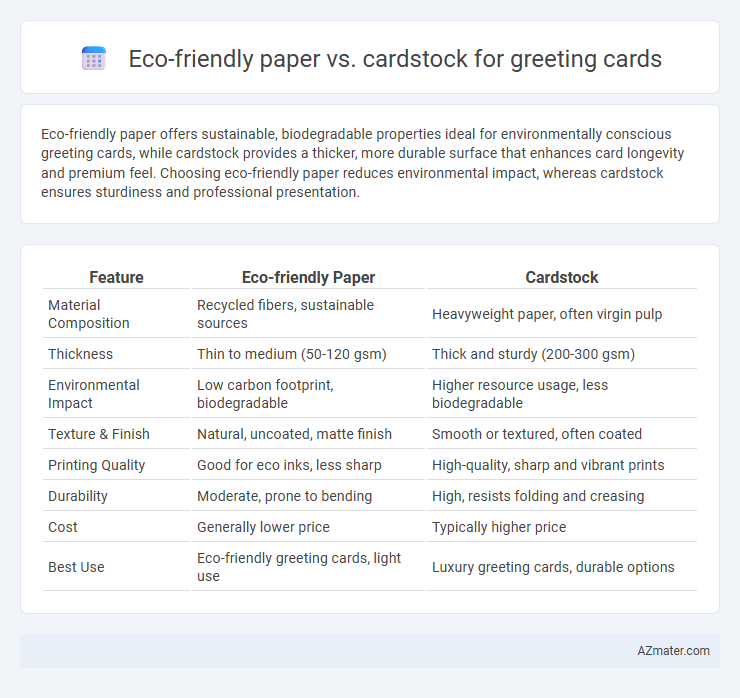Eco-friendly paper offers sustainable, biodegradable properties ideal for environmentally conscious greeting cards, while cardstock provides a thicker, more durable surface that enhances card longevity and premium feel. Choosing eco-friendly paper reduces environmental impact, whereas cardstock ensures sturdiness and professional presentation.
Table of Comparison
| Feature | Eco-friendly Paper | Cardstock |
|---|---|---|
| Material Composition | Recycled fibers, sustainable sources | Heavyweight paper, often virgin pulp |
| Thickness | Thin to medium (50-120 gsm) | Thick and sturdy (200-300 gsm) |
| Environmental Impact | Low carbon footprint, biodegradable | Higher resource usage, less biodegradable |
| Texture & Finish | Natural, uncoated, matte finish | Smooth or textured, often coated |
| Printing Quality | Good for eco inks, less sharp | High-quality, sharp and vibrant prints |
| Durability | Moderate, prone to bending | High, resists folding and creasing |
| Cost | Generally lower price | Typically higher price |
| Best Use | Eco-friendly greeting cards, light use | Luxury greeting cards, durable options |
Introduction to Eco-Friendly Greeting Card Materials
Eco-friendly greeting card materials prioritize sustainability by using recycled paper, plant-based fibers, or certified sustainable sources, reducing environmental impact compared to traditional cardstock. Eco-friendly paper is typically lighter and more biodegradable, while eco-friendly cardstock offers greater durability and thickness without compromising recyclability. Choosing materials with eco-certifications like FSC or made from post-consumer waste supports responsible forestry and waste reduction in greeting card production.
What is Eco-Friendly Paper?
Eco-friendly paper is made from recycled materials or sustainable sources such as bamboo, hemp, or FSC-certified wood pulp, designed to reduce environmental impact. It involves processes that minimize chemical use, water consumption, and carbon emissions, promoting biodegradability and recyclability. For greeting cards, eco-friendly paper offers a sustainable alternative to traditional cardstock by supporting responsible forestry and decreasing landfill waste.
Defining Cardstock for Greeting Cards
Cardstock for greeting cards is a thick, durable paper specifically designed to provide a sturdy, high-quality feel that enhances the presentation and longevity of the card. Typically ranging from 80 lb to 110 lb weight, cardstock offers excellent rigidity, making it ideal for folding and writing while resisting bending or tearing. Choosing eco-friendly cardstock options incorporates recycled fibers and sustainable sourcing, combining environmental responsibility with premium card performance.
Environmental Impact: Paper vs Cardstock
Eco-friendly paper for greeting cards typically uses recycled fibers and sustainable sources, significantly reducing deforestation and energy consumption compared to traditional cardstock. Cardstock, while thicker and more durable, often involves higher carbon emissions due to its heavier weight and the processing required to achieve its stiffness. Choosing eco-friendly paper helps minimize environmental impact by lowering waste, promoting biodegradability, and supporting renewable forestry practices.
Printing and Design Considerations
Eco-friendly paper offers a smooth surface ideal for high-quality ink absorption, ensuring vibrant colors and detailed prints on greeting cards. Cardstock provides greater thickness and durability, supporting embossing, foil stamping, and intricate die-cut designs without compromising structural integrity. Selecting between eco-friendly paper and cardstock depends on desired print finish, texture, and environmental impact priorities for the greeting card project.
Durability and Texture Differences
Eco-friendly paper offers a softer texture with a natural, recycled feel, making it ideal for environmentally conscious greeting cards, while cardstock provides superior durability due to its thicker, sturdier composition, ensuring the card withstands wear and handling. The density and weight of cardstock contribute to its resilience, allowing for more intricate designs and embellishments without bending or tearing. Eco-friendly paper's texture varies from smooth to rough, enhancing tactile appeal, but cardstock's firmness guarantees longevity and a premium finish that recipients appreciate.
Cost Comparison: Paper vs Cardstock
Eco-friendly paper for greeting cards generally costs less than eco-friendly cardstock due to its thinner, lighter material requiring fewer resources. Cardstock provides greater durability and premium feel, which increases production expenses, making it more expensive per sheet than eco-friendly paper. Bulk purchasing of eco-friendly paper reduces costs further, offering a budget-friendly option without sacrificing sustainability.
Recyclability and Compostability
Eco-friendly paper used for greeting cards offers superior recyclability due to its minimal chemical processing and absence of plastic coatings, allowing it to be easily repurposed in standard recycling streams. Cardstock, while often thicker and more durable, may contain synthetic fibers or finishes that reduce its compostability and complicate recycling efforts. Choosing highly recyclable and compostable eco-friendly paper supports sustainable waste management by promoting biodegradation and reducing landfill waste.
Best Uses for Each Material
Eco-friendly paper excels in greeting cards designed for casual communication, invitations, or environmentally conscious branding due to its recyclable properties and lightweight texture. Cardstock is best suited for premium or formal greeting cards, offering durability, sturdiness, and a professional finish that supports intricate designs and embellishments. Choosing between the two depends on the desired balance of sustainability, presentation quality, and card longevity.
Choosing the Right Option for Sustainable Greeting Cards
Eco-friendly paper offers biodegradable properties and minimal environmental impact, making it ideal for sustainable greeting cards that prioritize recyclability and reduced carbon footprint. Cardstock, while thicker and more durable, can be eco-friendly if sourced from recycled or FSC-certified materials, balancing sturdiness with sustainability. Selecting the right option depends on the desired card durability and commitment to using renewable or recycled resources to minimize ecological harm.

Infographic: Eco-friendly paper vs Cardstock for Greeting card
 azmater.com
azmater.com